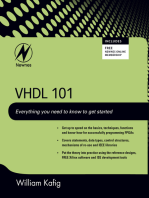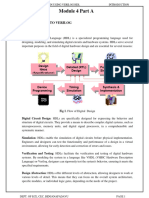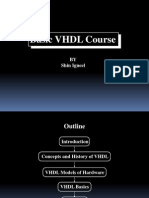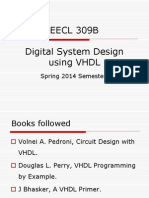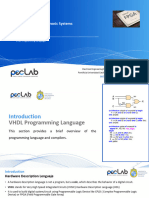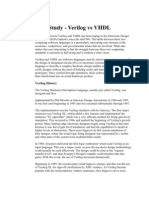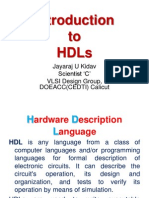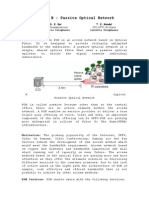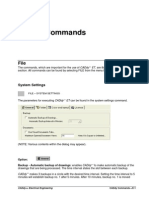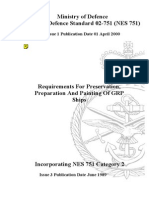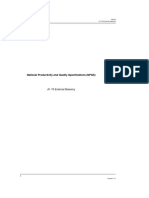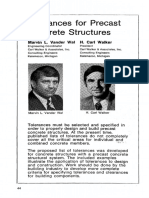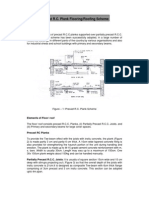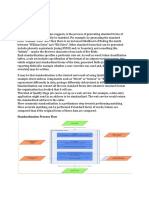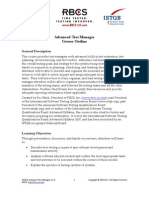Professional Documents
Culture Documents
Introduction To VHDL: EE 595 EDA / ASIC Design Lab
Uploaded by
Sudipta DasOriginal Description:
Original Title
Copyright
Available Formats
Share this document
Did you find this document useful?
Is this content inappropriate?
Report this DocumentCopyright:
Available Formats
Introduction To VHDL: EE 595 EDA / ASIC Design Lab
Uploaded by
Sudipta DasCopyright:
Available Formats
EE 595
Part I
Introduction to VHDL
EE 595 EDA / ASIC Design Lab
What is VHDL?
VHDL is a programming language that has been designed and
optimized for describing the behavior of digital circuits and
systems.
EE 595 EDA / ASIC Design Lab
What is VHDL? (cont‘d)
VHDL (VHSIC (Very High Speed Integrated Circuits) Hardware
Description Language) is becoming increasingly popular as a
way to capture complex digital electronic circuit for both
simulation and synthesis.
Digital circuits captured using VHDL can be easily simulated,
and more likely to be synthesized into multiple target
technologies, and can be archived for later modification and
reuse.
VHDL is a rich and powerful language.
EE 595 EDA / ASIC Design Lab
VHDL Language Features
VHDL has all the characteristics of a modern “programming”
language
Data types: predefined and user defined
Variables, Signals, and constants
Expressions: relational, logical, arithmetic, construction
Sequential Statements:
If, Case, For loop
Subprograms
Concurrent Statements:
Signal assignment, Concurrent processes, Component instances
Packages
Configurations
Dynamic memory allocation
File and input/output statements.
EE 595 EDA / ASIC Design Lab
Additional Benefits of VHDL
Allows for various design methodologies
Provides technology independence
Describes a wide variety of digital hardware
Eases communication through standard
language
Allows for better design management
Provides a flexible design language
Has given rise to derivative standards: VITAL,
Analog VHDL
EE 595 EDA / ASIC Design Lab
Goals of Language
Simulate-able specification for re-procurement
Standard format to exchange designs between
companies
Multi-vendor support
Support for huge designs
Determine behavior
EE 595 EDA / ASIC Design Lab
VHDL Versus Programming
Designing in VHDL is like programming in many ways. Compiling and
running a VHDL design is similar to compiling and running other
programming languages. First, the source design units are read by the
compiler, error messages are given by analyzer, and an object module is
produced and placed in a special VHDL library. Subsequently, a
simulation run is made, in which the object units from a library are
selected (configured) and loaded into a simulator. A set of test cases are
run, either in batch or interactive mode. The main difference is that a
VHDL design is always running in simulated time, and events occur in
successive time steps.
Differences
Differences
• The notation of delay and the simulation environment Not common in
• Concurrency, and component netlisting } programming languages
EE 595 EDA / ASIC Design Lab
VHDL Versus Programming
(cont’d)
A real hardware adder runs all the time, a design language needs a way of specifying
concurrent behavior (to represent the adder running in parallel with other simulated
hardware elements.) VHDL supports concurrency using the concept of concurrent
statements running in a simulation time; while concurrency is getting more
common, simulation time is a feature found only in simulation languages. In VHDL,
there are also sequential statements to describe algorithmic behavior.
Some programming languages provide for design hierarchy by having one main
Program and separately compiled subprograms. In VHDL, design hierarchy is
accomplished by separately compiled components that are instantiated in a higher-
level component. The linking process is done via the compiler, or by a simulator
using a VHDL library mechanism.
VHDL has a configuration capability for generating design variations.
EE 595 EDA / ASIC Design Lab
VHDL History
Very High Speed Integrated Circuit (VHSIC) Program
Launched in 1980
Aggressive effort to advance state of the art
Object was to achieve significant gains in VLSI technology
Need for common descriptive language
$17 Million for direct VHDL development
$16 Million for VHDL design tools
Woods Hole Workshop
Held in June 1981 in Massachusetts
Discussion of VHSIC goals
Comprised of members of industry, government, and
academia
EE 595 EDA / ASIC Design Lab
VHDL History (cont’d)
In July 1983, a team of Intermetrics, IBM and Texas
Instruments were awarded a contract to develop VHDL
In August 1985, the final version of the language under
government contract was released: VHDL Version 7.2
In December 1987, VHDL became IEEE Standard 1076-
1987 and in 1988 an ANSI standard
In September 1993, VHDL was restandardized to clarify
and enhance the language
VHDL has been accepted as a Draft International
Standard by the IEEE.
EE 595 EDA / ASIC Design Lab
IEEE Standard 1076-1987
In 1986, the IEEE was presented with a proposal to standardize the
language, which it did in 1987 after substantial enhancements and
modifications were made by a team of commercial, government
and academic representatives. The resulting standard, IEEE 1076
-1987, is the basis for virtually every simulation and synthesis
product sold today. An enhanced and updated version of language,
IEEE 1076-1993, was released in 1994, and VHDL tool vendors
have been responding by adding these new language features to
Their products.
EE 595 EDA / ASIC Design Lab
IEEE Standard 1164
Although IEEE standard 1076 defines the complete
VHDL language, there are aspects of the language
that make it difficult to write completely portable
design descriptions (descriptions that can be
simulated identically using different vendor’s tools).
z WHY? VHDL supports many abstract data types, but
does not directly address the problem of
characterizing different signal strengths or commonly
used simulation conditions such as unknowns and
high-impedance.
EE 595 EDA / ASIC Design Lab
IEEE Standard 1164 (cont’d)
To get around this problem of non- standard data types,
another standard was developed by the committee and
adopted by the IEEE. This standard, numbered 1164,
defines a standard package (a VHDL feature that allows
commonly used declarations to be collected into an
external library) containing definitions for a standard nine-
valued data type. This standard data type is called
standard logic, and the IEEE 1164 package is often
referred to as the standard logic package, or sometimes
MVL9 (for multi-valued logic, nine values).
EE 595 EDA / ASIC Design Lab
VITAL Initiative
The VITAL initiative (VHDL Initiative Toward ASIC
Libraries) effort to enhance VHDL’s abilities for modeling
timing in ASIC and FPGA design environments.
VITAL borrows liberally from existing methods for timing
annotation used in Verilog HDL. Specifically, the VITAL
standard (standard 1076.4)
Describes a method for annotating delay information using
the same underlying tabular format as specified in Verilog.
The adoptance of this standard will make it much easier
for ASIC and FPGA vendors to create timing-annotation
netlists and detailed behavior of devices.
EE 595 EDA / ASIC Design Lab
Top Down Design
In Top-Down Design methodology, designer
represents a system abstractly at first, and later in
more detail.
A VHDL description can be written at various levels
of abstraction:
Algorithmic
Register Transfer Level (RTL)
Gate Level functional with unit delay(structural)
Gate Level with detailed timing
EE 595 EDA / ASIC Design Lab
Top Down Design (cont’d)
VHDL provides ways of abstracting a design, or “hiding” implementation
details.
The algorithm can be evaluated in real(floating point), and later can be
Implemented in fixed-point integer.
(i.e. Designers often choose integers with 16 bits, but these
implementation decisions can be changed during a VHDL design cycle.)
In the previous example, addition is specified for 8-bit data. In actuality,
the + in this example might be a function call to user-written function called
plus (+). VHDL calls this technique operator overloading. Overloading is
another example of information hiding, which is convenient for the reader
and allows the design author to describe exactly what kind of operator is
wanted (+).
EE 595 EDA / ASIC Design Lab
VHDL Design Steps
Design Description
in VHDL
Behavioral Identity requirements -
Simulation capacity & performance
RTL Level
Experiment with alternate functionality
Simulation
Experiment with alternate
Synthesizeable
implementations and verify function
RTL
Gate Level
Implementation
Gate Level Regression Test
Simulation
EE 595 EDA / ASIC Design Lab
Simulation
A design description or model, written in VHDL, is usually run through a VHDL
simulator to demonstrate the behavior of the modeled system. Simulating a
VHDL design model requires simulated stimulus, a way of observing the model
during simulation, and capturing the results of simulation for later inspection.
Designer usually creates a set of test cases, for inputs and expected results, to
verify the function of the design. This file is called Testbench. For the previous
ADDER example, we would provide a set of functional test vectors as:
at
atsimulated
simulatedtime
time0:
0: B=
B=“0000
“00000010”
0010”
C=
C=“0000
“00000010”
0010”
The simulator would run to cover at least 5 ns of simulation time, and we could observe the output
on the A bus:
AA==“0000
“00000100”
0100”
EE 595 EDA / ASIC Design Lab
Simulation (cont’d)
Logic simulator systems need to represent undefined or “unknown” values
for circuits with unresolved electrical values or states, which might be the
output of this circuit model during the first 4 ns of simulation time.
Accordingly, VHDL supports a variety of data types useful to the hardware
modeler for both simulation, and synthesis, as well as bits, booleans, and
numbers, which are defined in the Package STANDARD.
During simulation, the ADDER example is modeled on a computer
system, where the values on the busses are stored in the computer’s
memory. Hence, A, B, and C are similar to variables in programming
languages that change value over the time, and can be observed while the
program is running.
EE 595 EDA / ASIC Design Lab
Logic Synthesis
Some parts of VHDL can be used with logic synthesis tools for producing a
physical design. In particular, many VLSI gate-array vendors can convert
a VHDL design description into a gate level netlist from which a
customized integrated circuit component can then be built. Hence the
application of VHDL is for:
• Documenting a design
• Simulating the behavior of a design
• Directly synthesizing logic
The ADDER is an abstraction of a real adder circuit, which might have
varying delays that are dependent upon the data, or on whether an output
rises or falls. Although a logic synthesis tool could generate an 8-bit adder
circuit, it could not produce an ideal adder with exactly 5.0 ns delay for all
cases. Only the addition function (not the delay specification) of the
statement in the example could be synthesized into a physical device.
(Delays and time specifications are ignored in Logic Synthesis.)
EE 595 EDA / ASIC Design Lab
You might also like
- Welcome To The VHDL LanguageDocument399 pagesWelcome To The VHDL LanguageardserNo ratings yet
- Intro VHDL PDFDocument12 pagesIntro VHDL PDFkokome350% (1)
- VHDL 101: Everything you Need to Know to Get StartedFrom EverandVHDL 101: Everything you Need to Know to Get StartedRating: 2.5 out of 5 stars2.5/5 (2)
- 1 IntroDocument33 pages1 IntroTom CruseNo ratings yet
- Digital Integrated Circuit Design Using Verilog and SystemverilogFrom EverandDigital Integrated Circuit Design Using Verilog and SystemverilogRating: 3 out of 5 stars3/5 (4)
- Main Topics:: Circuit Design Based On VHDL VHDL Basics Advanced VHDL Language Structures Circuit ExamplesDocument33 pagesMain Topics:: Circuit Design Based On VHDL VHDL Basics Advanced VHDL Language Structures Circuit ExamplesRoshdy AbdelRassoulNo ratings yet
- Software Engineering for Embedded Systems: Methods, Practical Techniques, and ApplicationsFrom EverandSoftware Engineering for Embedded Systems: Methods, Practical Techniques, and ApplicationsRating: 2.5 out of 5 stars2.5/5 (2)
- Vhsic: VHDL (Hardware Description Language) Is ADocument24 pagesVhsic: VHDL (Hardware Description Language) Is Aluke tigerNo ratings yet
- Modern X86 Assembly Language Programming: Covers x86 64-bit, AVX, AVX2, and AVX-512From EverandModern X86 Assembly Language Programming: Covers x86 64-bit, AVX, AVX2, and AVX-512No ratings yet
- Module 4A HDL Intro 04-12-23Document15 pagesModule 4A HDL Intro 04-12-23raovinayakm2No ratings yet
- Image Collection Exploration: Unveiling Visual Landscapes in Computer VisionFrom EverandImage Collection Exploration: Unveiling Visual Landscapes in Computer VisionNo ratings yet
- Vlsi VivaDocument9 pagesVlsi VivaNimisha KhandelwalNo ratings yet
- VHDLDocument5 pagesVHDLRoemil CabalNo ratings yet
- VHDL 160909Document69 pagesVHDL 160909kuntaladasNo ratings yet
- Basic VHDL Course: BY Shin IgneelDocument19 pagesBasic VHDL Course: BY Shin IgneelShin IgneelNo ratings yet
- VHDL Vs VerilogDocument16 pagesVHDL Vs Verilogmnpaliwal020No ratings yet
- VerilogDocument2 pagesVerilogAbani MeherNo ratings yet
- Main Topics:: Circuit Design Based On VHDL VHDL Basics Advanced VHDL Language Structures Circuit ExamplesDocument33 pagesMain Topics:: Circuit Design Based On VHDL VHDL Basics Advanced VHDL Language Structures Circuit Examplesnandan_pappuNo ratings yet
- Main Topics:: Circuit Design Based On VHDL VHDL Basics Advanced VHDL Language Structures Circuit ExamplesDocument33 pagesMain Topics:: Circuit Design Based On VHDL VHDL Basics Advanced VHDL Language Structures Circuit ExamplesnamratashakyaNo ratings yet
- VHDLDocument33 pagesVHDLsansureNo ratings yet
- DSD Using VHDLDocument54 pagesDSD Using VHDLShashi Bhushan Kotwal100% (1)
- History of VHDL DevelopmentDocument17 pagesHistory of VHDL DevelopmentRittal 96No ratings yet
- 2.VLSI Design Using Verilog HDL 2.1 Explain The Steps Involved in The Design Flow For The VLSI IC Design: Typical Design FlowDocument21 pages2.VLSI Design Using Verilog HDL 2.1 Explain The Steps Involved in The Design Flow For The VLSI IC Design: Typical Design FlowDinesh PalavalasaNo ratings yet
- Manual SelfDocument133 pagesManual Selfchiranjeevee02No ratings yet
- Paradigm Concurrent, Reactive First Appeared 1980s Typing Discipline StrongDocument9 pagesParadigm Concurrent, Reactive First Appeared 1980s Typing Discipline Strongamerico medinaNo ratings yet
- History: U.S Department of Defense AsicsDocument2 pagesHistory: U.S Department of Defense AsicssvdikitNo ratings yet
- Vlsi Design Using VHDLDocument20 pagesVlsi Design Using VHDLAbhinav ShuklaNo ratings yet
- Hardware Description LanguageDocument23 pagesHardware Description Languagesai praneethNo ratings yet
- About VlsiDocument14 pagesAbout VlsiAnonymous 1aqlkZNo ratings yet
- HDL Lab Ece Uvce Jan20Document50 pagesHDL Lab Ece Uvce Jan20Bhavid ANo ratings yet
- 16ECU19 - VLSI Design and VHDL: Introduction and Basic Concept of VHDL Session IDocument42 pages16ECU19 - VLSI Design and VHDL: Introduction and Basic Concept of VHDL Session Iசெல்வம் முத்துராமன்No ratings yet
- VHDL Slide Nectec PDFDocument162 pagesVHDL Slide Nectec PDFภัทรชัย โรจนนาคNo ratings yet
- Project Report On Implementation of Some Basic Hardware Designs at FPGA Using VERILOGDocument27 pagesProject Report On Implementation of Some Basic Hardware Designs at FPGA Using VERILOGAnkitGarg100% (1)
- VerilogDocument29 pagesVerilogyp2401553No ratings yet
- VHDL-Unit-2-Part-5 1Document92 pagesVHDL-Unit-2-Part-5 1TanishaNo ratings yet
- VHDL Unit 2 Part 3Document45 pagesVHDL Unit 2 Part 3TanishaNo ratings yet
- VHDL Unit 2 Part 4Document61 pagesVHDL Unit 2 Part 4TanishaNo ratings yet
- VHDL Unit 2 Part 2Document25 pagesVHDL Unit 2 Part 2TanishaNo ratings yet
- CME 4456 Reconfigurable Computing: Şerife YILMAZDocument72 pagesCME 4456 Reconfigurable Computing: Şerife YILMAZB. TNo ratings yet
- HDL Programming Lab Manual Final UpdatedDocument77 pagesHDL Programming Lab Manual Final UpdateddeepaNo ratings yet
- VHDLDocument324 pagesVHDLKrishna Chaitanya T75% (4)
- VHDL Unit 2 Part 1Document20 pagesVHDL Unit 2 Part 1TanishaNo ratings yet
- Thesis Based On VHDLDocument8 pagesThesis Based On VHDLevkrjniig100% (2)
- VHDLDocument94 pagesVHDLAkshay MandawariaNo ratings yet
- VLSI System Design & Modeling TechniqueDocument46 pagesVLSI System Design & Modeling TechniqueShuvodip DasNo ratings yet
- VHDLDocument50 pagesVHDLJayant JamwalNo ratings yet
- Essential VHDLDocument127 pagesEssential VHDLMelody ShieldsNo ratings yet
- 02.-Introduction VHDL ProgrammingDocument71 pages02.-Introduction VHDL ProgrammingFarias Ben JaNo ratings yet
- Programmable Logic Design With VHDLDocument198 pagesProgrammable Logic Design With VHDLDaniel CornelioNo ratings yet
- VHDL NotesDocument40 pagesVHDL Notesangel_hunNo ratings yet
- Hardware Description Languages and Programmable LogicDocument30 pagesHardware Description Languages and Programmable LogicJay UlomiNo ratings yet
- Introduction To HDLDocument28 pagesIntroduction To HDLBack UpNo ratings yet
- Design Methods: Verilog HDL VHDLDocument6 pagesDesign Methods: Verilog HDL VHDLNiranjan BeheraNo ratings yet
- Case Study VHDLDocument6 pagesCase Study VHDLSneha KaurNo ratings yet
- Tutorial 1Document3 pagesTutorial 1Xzk KhooiNo ratings yet
- 1.introduction To HDLsDocument32 pages1.introduction To HDLsSiby JosephNo ratings yet
- HDL Manual 2018 19 UpdatedDocument59 pagesHDL Manual 2018 19 UpdatedNisha TNo ratings yet
- Report VHDL PDFDocument31 pagesReport VHDL PDFShailesh PrajapatiNo ratings yet
- Iptv Over PonDocument5 pagesIptv Over Ponchaidar_lakareNo ratings yet
- BoschVMS Configuration Manual EnUS 20710700043Document390 pagesBoschVMS Configuration Manual EnUS 20710700043xyzNo ratings yet
- Internal & External Inspection GuidelinesDocument5 pagesInternal & External Inspection Guidelinesgeverett2765No ratings yet
- International Oil Pollution Prevention Certificate (Iopp Certificate)Document5 pagesInternational Oil Pollution Prevention Certificate (Iopp Certificate)Sriram Ramaswami100% (1)
- EN1993 - Benchmarks SCIA PDFDocument212 pagesEN1993 - Benchmarks SCIA PDFAnonymous 19QCaJNo ratings yet
- PIP PLSC0018 Requirements For Welder Qualifications in Accordance With API 1104Document19 pagesPIP PLSC0018 Requirements For Welder Qualifications in Accordance With API 1104Bob LeeNo ratings yet
- E Caddy CommandsDocument194 pagesE Caddy CommandsJunior MarcosNo ratings yet
- NES 751 Requirements For Preservation, Preparation and Painting of GRP Ships (Superseded by NES 863) Category 2Document94 pagesNES 751 Requirements For Preservation, Preparation and Painting of GRP Ships (Superseded by NES 863) Category 2JEORJENo ratings yet
- #!sunnydays RedactedDocument386 pages#!sunnydays RedactedDan StuckeyNo ratings yet
- Toshiba Satellite L65Document48 pagesToshiba Satellite L65Rommel LoayzaNo ratings yet
- Madrasah Tsanawiyah Miftahul Huda Majalengka Status Terakreditasi ADocument5 pagesMadrasah Tsanawiyah Miftahul Huda Majalengka Status Terakreditasi Aaziz ilmanudinNo ratings yet
- User Manual For Naxys Ethernet Hydrophone Model 02345 Manual - February 2008Document20 pagesUser Manual For Naxys Ethernet Hydrophone Model 02345 Manual - February 2008JAIME CIFUENTESNo ratings yet
- Ceragon FibeAir IP 20N Technical Description 10.9 Rev A.04Document468 pagesCeragon FibeAir IP 20N Technical Description 10.9 Rev A.04Anonymous hhzIYBNo ratings yet
- A1-70 External Masonry - 1Document24 pagesA1-70 External Masonry - 1ZYWNo ratings yet
- Svi - STP: STP Signal Transfer PointDocument2 pagesSvi - STP: STP Signal Transfer PointAdeNo ratings yet
- Tolerances For Precast Concrete Structures PDFDocument14 pagesTolerances For Precast Concrete Structures PDFHari HaranNo ratings yet
- Third Party Risk Management ServicesDocument8 pagesThird Party Risk Management ServicesManoj100% (1)
- Juniper Modules Ex Series OverviewDocument316 pagesJuniper Modules Ex Series Overviewskibum415No ratings yet
- ServeincaDocument8 pagesServeincathelordmauNo ratings yet
- TFR1 Precast RCDocument19 pagesTFR1 Precast RCvaibhavsensesNo ratings yet
- DQ StandardizationDocument24 pagesDQ Standardizationabreddy2003No ratings yet
- Switching Basics and Intermediate RoutingDocument19 pagesSwitching Basics and Intermediate RoutingkirtookoonNo ratings yet
- TCPN Running Procedures REV BDocument7 pagesTCPN Running Procedures REV BGouldNo ratings yet
- Standards Mentioned at PETROBRAS Offshore Basic DesignsDocument11 pagesStandards Mentioned at PETROBRAS Offshore Basic DesignsErnestoSalMarNo ratings yet
- Aero CellDocument2 pagesAero Cellangga pratamaNo ratings yet
- Cisco UBR7200 Series Software Configuration GuideDocument324 pagesCisco UBR7200 Series Software Configuration GuideMiki RubirozaNo ratings yet
- DSE6110 Installation InstructionsDocument2 pagesDSE6110 Installation InstructionsARAFAN nahi33% (3)
- Magcloud Instructions 8.25x10.75StandardPB PhotoshopDocument16 pagesMagcloud Instructions 8.25x10.75StandardPB PhotoshopjcecilNo ratings yet
- Classic Mini Cooper Christmas 2010Document31 pagesClassic Mini Cooper Christmas 2010minimaniaNo ratings yet
- Istqb Advanced Test Manager Rev 1.0Document8 pagesIstqb Advanced Test Manager Rev 1.0rajkmm36No ratings yet




